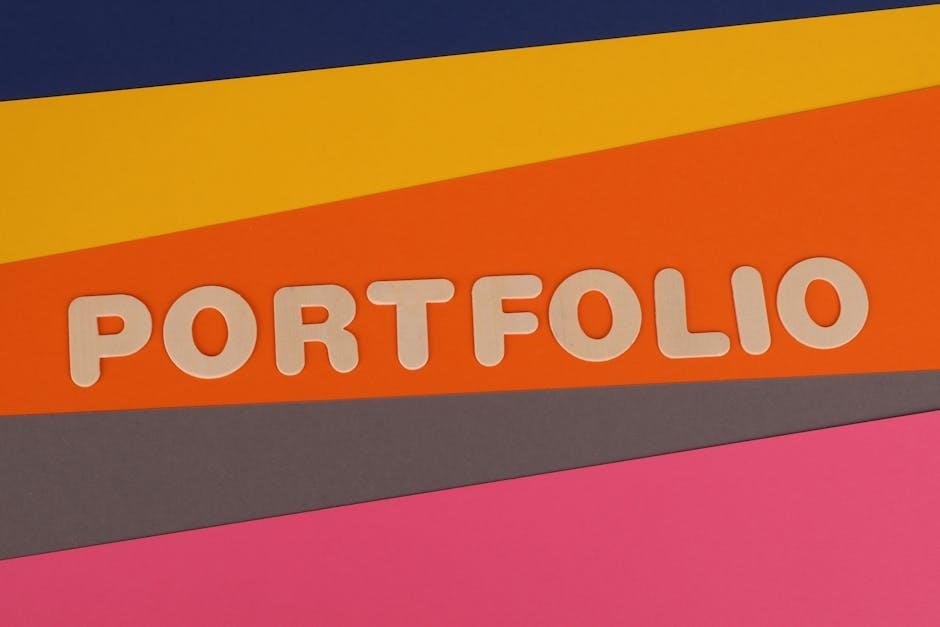graphic design portfolio examples pdf
A graphic design portfolio is a crucial tool for showcasing creativity and skills, with PDF formats offering a versatile and professional way to present work. Whether for job applications or client presentations, a well-crafted PDF portfolio balances visual appeal with functionality, making it easier to share and view designs across different platforms. In a competitive design landscape, a polished portfolio is essential for standing out, demonstrating attention to detail, and conveying a designer’s unique style. This guide explores the importance, structure, and best practices for creating impactful PDF portfolios that leave a lasting impression.

What is a Graphic Design Portfolio?
A graphic design portfolio is a curated collection of a designer’s best work, showcasing their creativity, skills, and expertise. It serves as a visual testament to their ability to solve design problems and create aesthetically pleasing solutions. Whether in digital or print format, a portfolio highlights key projects, case studies, and concept art, demonstrating the designer’s versatility and style. For emerging designers, it’s a tool to prove their capabilities, while for professionals, it reinforces their reputation. A well-structured portfolio not only displays finished designs but also tells the story behind them, revealing the designer’s thought process and attention to detail. It’s an essential asset for job applications, client presentations, and building a strong professional presence.
Why is a Portfolio Essential for Graphic Designers?
A portfolio is indispensable for graphic designers as it bridges the gap between their skills and real-world opportunities. It acts as a visual resume, allowing employers and clients to assess their creative abilities and problem-solving talents. In a competitive field, a strong portfolio differentiates designers, showcasing their unique style and versatility. It builds credibility, making it easier to secure jobs or attract clients. Additionally, a portfolio facilitates self-reflection and growth, helping designers refine their work and identify strengths. Without a portfolio, designers struggle to demonstrate their value, making it a non-negotiable tool for advancing their careers and standing out in the industry.
Understanding the Importance of PDF Portfolios
PDF portfolios offer versatility and professional presentation, making them ideal for showcasing graphic design work. They are easy to share, maintain consistent layouts, and are accessible on any device, ensuring designers make a strong impression.
Benefits of Using PDF for Graphic Design Portfolios
Using PDF for graphic design portfolios offers numerous advantages, including easy sharing, consistent formatting, and professional presentation. PDFs are universally accessible and maintain design integrity across devices. They allow for interactivity, such as clickable links and navigation, enhancing user experience. PDFs are also secure, preventing unauthorized edits, and can be easily emailed or downloaded. Their compact file size ensures quick loading, making them ideal for digital submissions. Additionally, PDFs can be optimized for both screen and print, providing versatility for different viewing preferences. These benefits make PDFs a practical and effective choice for showcasing graphic design work in a polished and professional manner.
How PDF Portfolios Compare to Online Portfolios
PDF portfolios and online portfolios each have unique strengths. PDFs offer a controlled, professional presentation with consistent formatting and offline accessibility, ideal for email submissions or print. Online portfolios, however, provide dynamic interactivity, easier updates, and a more immersive experience. While PDFs are compact and secure, online portfolios allow for better user engagement through clickable links, animations, and responsive design. PDFs are often preferred for their portability and universal compatibility, whereas online portfolios excel in showcasing process and storytelling. The choice depends on the context: PDFs are great for job applications or client reviews, while online portfolios are better for showcasing ongoing work and creativity. Both formats complement each other in a designer’s toolkit.
Key Elements of a Successful PDF Portfolio
A successful PDF portfolio requires a clear structure, high-quality content, and strong visual appeal. It should be easy to navigate, with consistent design and professional presentation that reflects the designer’s style and creativity.
Structure and Layout
A well-organized structure and layout are vital for a PDF portfolio. Start with a clear cover page, followed by a table of contents to guide viewers. Use page numbers and section dividers to enhance navigation. Ensure consistent spacing, alignment, and typography throughout. A clean grid system can help maintain balance and readability. Avoid overly complex layouts that distract from the work. Instead, use white space effectively to create a professional and polished appearance. Proper structure ensures the portfolio is easy to follow, allowing the viewer to focus on the quality and creativity of the designs. This logical flow enhances the overall viewing experience and professionalism of the portfolio.
Content and Project Showcase
Your PDF portfolio should showcase your best and most relevant work, demonstrating your skills and versatility as a graphic designer. Include a variety of projects that highlight your expertise in different areas, such as branding, typography, or digital design. Use high-quality images and ensure projects are presented in a visually appealing manner. Provide context for each piece, explaining the concept, goals, and your role in the project. Case studies or “before and after” examples can add depth, showing your problem-solving process. Avoid overcrowding pages—focus on clarity and impact. Tailor your content to your target audience, ensuring it aligns with the type of work you want to attract. This curated approach will make your portfolio both professional and engaging.
Visual Appeal and Design Consistency
Visual appeal and design consistency are critical for a professional graphic design portfolio. A cohesive visual identity ensures your work is presented in a polished and organized manner. Use a consistent color scheme, typography, and spacing throughout the PDF to create a professional look. High-quality images and thoughtful layout design will enhance the visual impact of your projects. Avoid overwhelming the viewer with too many design elements—instead, balance aesthetics with functionality. Consistency in styling helps guide the viewer through your portfolio seamlessly. Ensure your design choices complement your work rather than distract from it, maintaining a focus on clarity and readability. This attention to detail reinforces your credibility as a skilled graphic designer.

Creating an Effective PDF Portfolio

Creating an effective PDF portfolio involves balancing creativity with functionality. Use high-quality images, clear typography, and intuitive navigation to showcase your graphic design skills and personal style effectively.
Curating Your Best Work
Curating your best work is essential for a standout graphic design portfolio. Showcase projects that highlight your technical skills, creativity, and attention to detail. Include a variety of pieces that demonstrate your versatility across different design disciplines, such as branding, typography, and digital design. Prioritize high-quality, finished work over incomplete drafts, as employers seek polished results. Tailor your portfolio to the job or client by selecting projects that align with their needs. Use case studies to explain your design process, from concept to execution, emphasizing problem-solving and innovation. Avoid overcrowding—focus on 10-15 standout pieces. Regularly update your portfolio to reflect your growth and remove outdated work. This curation ensures your portfolio is professional, engaging, and relevant to your goals.

Designing for Visual Impact
Designing for visual impact is critical to captivate your audience. Use high-resolution images and a clean, professional layout to ensure your work shines. Select a consistent color scheme and typography that reflect your brand and enhance readability. Avoid clutter by balancing text and imagery, ensuring each project has breathing space. Utilize design elements like grids, alignment, and white space to create a polished look. Incorporate interactive features in your PDF, such as hyperlinks or buttons, to enhance navigation. Ensure your portfolio is responsive and adapts well to different screen sizes for seamless viewing. By focusing on aesthetics and usability, your PDF portfolio will leave a lasting impression and showcase your design expertise effectively.

Optimizing for Digital Viewing
Optimizing your PDF portfolio for digital viewing ensures it looks professional across devices. Compress images to reduce file size without sacrificing quality, and use high-resolution visuals for sharp displays. Ensure text is legible on both mobile and desktop screens by selecting clear, readable fonts. Organize content with bookmarks or a table of contents for easy navigation. Incorporate hyperlinks to websites or case studies for added interactivity. Use vector graphics for scalable illustrations that maintain clarity. Test your PDF on various devices to ensure consistency. Avoid overly complex layouts that may slow loading times. By prioritizing usability and visual clarity, your portfolio will deliver a seamless viewing experience for potential employers or clients.
Case Studies and Examples

Professional graphic design portfolios in PDF format showcase creativity and technical skills. Examples highlight how designers secure jobs or clients through visually appealing, well-organized presentations of their work.
Professional Graphic Design Portfolio Examples
Professional graphic design portfolios in PDF format often feature sleek, minimalist designs that highlight a designer’s best work. For instance, Matt’s portfolio, which secured his place at Falmouth University, showcases a clean layout and high-quality visuals. Similarly, Morgane Peng’s portfolio demonstrates how to create engaging hooks and headlines, making the work stand out. These examples emphasize the importance of visual appeal, consistency, and storytelling. They also illustrate how a well-organized PDF can effectively communicate a designer’s style and expertise, whether for academic admission or professional opportunities. By studying these examples, aspiring designers can gain insights into structuring their own portfolios for maximum impact.
Student and Emerging Designer Portfolios
Student and emerging designer portfolios often showcase creativity and potential, even with limited professional experience. These portfolios highlight academic projects, personal initiatives, and internships, demonstrating skill development and versatility. For example, Matt’s portfolio secured his place at Falmouth University by presenting a clean, visually appealing layout. Emerging designers also use PDFs to share their work, emphasizing strong visuals and clear storytelling. Tips for students include using hypothetical projects or volunteer work to build a standout portfolio. By focusing on attention to detail and design consistency, these portfolios prove that experience can be demonstrated through quality and creativity, helping students stand out in competitive design fields.

Best Practices for PDF Portfolios
Ensure your PDF portfolio is visually consistent, well-organized, and optimized for digital viewing. Keep layouts clean, use high-quality images, and maintain fast loading times for seamless user experience.

Formatting and Size Considerations
When creating a PDF portfolio, it’s essential to consider formatting and size to ensure accessibility and professionalism. Use standard page dimensions like A4 or letter size for consistency. Optimize resolution for high-quality visuals without excessive file sizes, aiming for 72-300 DPI. Keep the file size under 10MB for easy sharing and fast loading. Use a clean, readable font and maintain proper spacing. Ensure layouts are visually balanced, with text and images complementing each other. Avoid overly complex designs that may slow down loading times. Consider including page numbers and a table of contents for easy navigation. Finally, test the PDF on different devices to ensure compatibility and seamless viewing across platforms.
Interactivity and Navigation
Enhancing interactivity in your PDF portfolio can elevate the viewer experience, making it more engaging and user-friendly. Incorporate features like bookmarks for easy section navigation and hyperlinks to connect related projects or external resources. Interactive buttons or clickable images can direct viewers to detailed case studies or websites. Use page transitions sparingly to add visual interest without overwhelming the audience. A well-organized table of contents is essential for quick access to specific sections. Ensure smooth scrolling and consider adding a navigation pane for larger portfolios. Test the PDF on various devices to ensure compatibility and consistent performance. Balancing aesthetics with intuitive navigation will make your portfolio both visually appealing and practical for reviewers to explore.
A well-crafted graphic design portfolio is your creative ambassador, showcasing skills and style. Prioritize clarity, originality, and visual appeal to leave a lasting impression. Stand out in a competitive industry with a portfolio that reflects your unique vision and professionalism.
Final Tips for a Standout Portfolio
To create an exceptional graphic design portfolio, focus on clarity, originality, and visual appeal. Tailor your content to your target audience, ensuring each project tells a story. Use high-quality images and consistent formatting to maintain professionalism. Include a clear call-to-action, such as your contact information, and ensure seamless navigation. Proofread thoroughly to avoid errors. Highlight your unique design voice while demonstrating versatility. Regularly update your portfolio with fresh projects to showcase growth. Pay attention to detail, as it reflects your commitment to excellence. A standout portfolio is not just a collection of work—it’s a testament to your creativity and skill, helping you leave a lasting impression on employers or clients.
